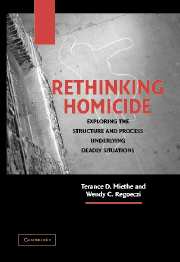Book contents
- Frontmatter
- Contents
- List of Figures
- List of Tables
- Preface
- Acknowledgments
- Rethinking Homicide
- 1 Introduction: Studying Homicide Situations
- 2 Theoretical Development
- 3 Data and Methodology for Studying Homicide Situations
- 4 The Empirical Distribution of Homicide
- 5 Instrumental and Expressive Motives in Homicide Situations
- 6 Gender Differences in the Structure of Homicide Situations
- 7 Change and Stability in the Structure of Youth Homicide
- 8 Racial Differences in Homicide Situations
- 9 Victim–Offender Relationships
- 10 Conclusions and Implications
- References
- Author Index
- Subject Index
Preface
Published online by Cambridge University Press: 11 July 2009
- Frontmatter
- Contents
- List of Figures
- List of Tables
- Preface
- Acknowledgments
- Rethinking Homicide
- 1 Introduction: Studying Homicide Situations
- 2 Theoretical Development
- 3 Data and Methodology for Studying Homicide Situations
- 4 The Empirical Distribution of Homicide
- 5 Instrumental and Expressive Motives in Homicide Situations
- 6 Gender Differences in the Structure of Homicide Situations
- 7 Change and Stability in the Structure of Youth Homicide
- 8 Racial Differences in Homicide Situations
- 9 Victim–Offender Relationships
- 10 Conclusions and Implications
- References
- Author Index
- Subject Index
Summary
We are exposed to a phenomenal amount of information about homicide in everyday life. It is the focus of local and national news, a primary theme in TV dramas and motion pictures, and the prime material in “true crime” magazines and the widely popular murder mystery. Homicide sells in most Western countries because of its novelty and seriousness. Although statistically the least frequently committed major crime, the public is often totally enthralled and mesmerized by homicide. This fascination with homicide is understandable given that it offends the basic values we place on human life and vulgarizes the presumed civility and moral supremacy of modern culture.
Criminologists in the social sciences are not immune to these forces. We are equally captivated and appalled by lethal violence, devoting far more attention to homicide than any other criminal act. The scientific literature on homicide is absolutely enormous. Lethal violence is an omnipresent topic in major criminological journals. Most critical tests of existing theories of crime causation and its distribution have focused on lethal violence because it is widely held that official counts of homicide are more reliable and valid than for any other major crime category. Furthermore, public policies on crime prevention and research on risk factors are disproportionately directed toward violence.
Using this vast scientific literature on lethal violence as the background, our goal in this book is to encourage “rethinking” about homicide as it relates to how we describe, explain, and study it.
- Type
- Chapter
- Information
- Rethinking HomicideExploring the Structure and Process Underlying Deadly Situations, pp. xvii - xxPublisher: Cambridge University PressPrint publication year: 2004

